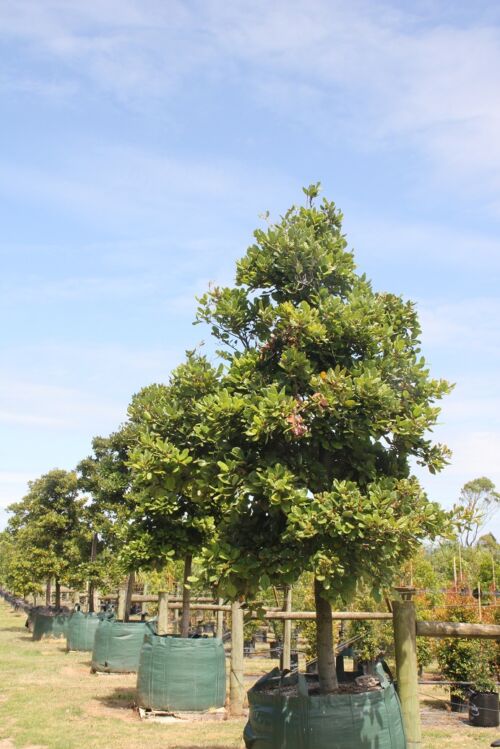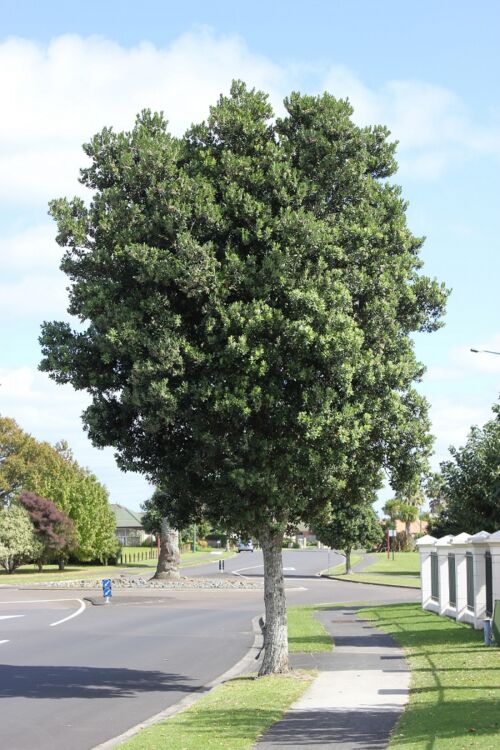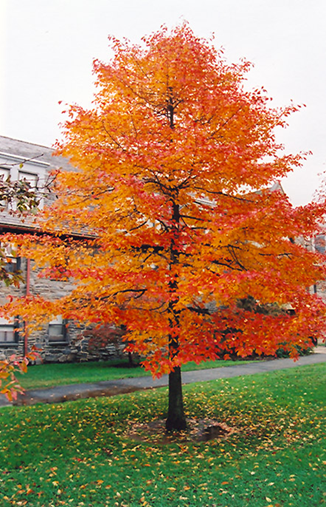Bird Feeding Trees
-
- Description
Handsome NZ Native stately straight and erect trunk has smooth brown bark. Eventually grow to a large canopy tree. Small flowers appear in panicles in spring followed by attractive purple fruit in autumn which are the favourite of the Native Kereru pigeon. Likes rich deeply worked well drained soil. Height x Width 20 x 6 Height Range Tall 10+ Growth Rate Moderate Plant Type Tree Shape / Habit Conical Country of Origin New Zealand Similar to Consider Planchonella costata, Alectryon Excelsa - Leaf
Leaf Colour Green - Flower
Flower Colour Orange Fragrant? No - Uses
Specimen Yes Bird Feeding Yes Note: Growth, height and grade information are given in good faith but are subject to natural variables beyond our control. -
- Description
A vigorous small tree with long, narrow green leaves with slightly pendulous branches. Bright red flower spikes carried in clusters over spring and early summer provides nectar for bees and birds. Tolerates coastal, wind, clay, sandy or dry once established. Height x Width 3 x 2 Height Range Small 1-5m Growth Rate Fast Plant Type Tree Shape / Habit Round Country of Origin Australia Similar to Consider C. Red Clusters, Salignus (Yellow) Citrinus Violetii (Violet) - Leaf
Leaf Colour Green - Flower
Flower Colour Red Fragrant? No - Uses
Screening / Shelter Yes Hedging Yes Bird Feeding Yes Note: Growth, height and grade information are given in good faith but are subject to natural variables beyond our control. -
- Description
Vigorous large shrub, new leaves emerge a silvery-pink turning to mid- green. Masses of red bottlebrush flowers with gold anthers appear in spring and autumn. Tolerant of poor dry soils once established, though prefers some moisture. Provides nectar for bees and birds. Good for hedging. Height x Width 3 x 2 Height Range Small 1-5m Growth Rate Moderate Plant Type Shrub Shape / Habit Round Country of Origin Australia Similar to Consider Kings Park Special, Salignus (Yellow) Citrinus Violetii (Violet) - Leaf
Leaf Colour Green - Flower
Flower Colour Red Fragrant? No - Uses
Screening Yes Hedging Yes Bird Feeding Yes Fruit Producing Note: Growth, height and grade information are given in good faith but are subject to natural variables beyond our control. -
- Description
Cordyline australis - Cabbage Tree Cabbage tree: An iconic New Zealand palm like tree. Long drooping slender leaves up to 1m long are clustered at the tips of the branches. Large heads of scented creamy white flowers in Nov produce nectar for bees, then fruit attracts birds from January-April. Commonly found throughout farmland, open places, wetlands and scrubland of the North and South Islands in anything from wet swampy ground to dry windy hill slopes. Hardy. Height x Width 6 x 2 Height Range Small 1-5m Growth Rate Slow Plant Type Palm Shape / Habit Upright Country of Origin New Zealand Similar to Consider Nikau Palms - Leaf
Leaf Colour Green - Flower
Flower Colour White Fragrant? Yes - Uses
Accent Yes Bird Feeding Yes Note: Growth, height and grade information are given in good faith but are subject to natural variables beyond our control. -
- Description
A slender growing shrub with rich green foliage and masses of starry yellow flowers early summer followed by dark red berries. Attracts birds. Ideal as a hedge trims well. Will tolerate dry coastal exposed or windy sites once established. Height x Width 2 x 1.2 Height Range Small 1-5m Growth Rate Moderate Plant Type Shrub Shape / Habit Round Country of Origin New Zealand Similar to Consider Syzygium resilience, Michelia Figo, Camellias, Pittosporums, Griselinia, Ficus, Ilex largo, Olea El Greco, Eugenia Ventinatii - Leaf
Leaf Colour Green - Flower
Flower Colour Yellow Fragrant? No - Uses
Hedging Yes Bird Feeding Yes Note: Growth, height and grade information are given in good faith but are subject to natural variables beyond our control. -
- Description
New Zealand’s largest Native tree. Grows in swampy areas but also grows well in dry flat and hilly locations between sea level and up to 600m once established. Medium wind tolerance. Height x Width 40 x 6 Height Range Tall 10+ Growth Rate Fast Plant Type Tree Shape / Habit Pyramidical Country of Origin New Zealand Similar to Consider Liriodendron tulipifera fastigiata, Olea El Greco, Knightia Excelsa, Dacrydium Cuprissinum, Acer Bowall, Poplar crow’s nest, Quercus robur fastigiata, Carpinus Betulus fastigiata, - Leaf
Leaf Colour Green bronze - Flower
Flower Colour Insignificant - Uses
Screening Yes Bird Feeding Yes Note: Growth, height and grade information are given in good faith but are subject to natural variables beyond our control. -
- Description
One of the most widespread of New Zealand forest trees. The leaves are small and awl-shaped and form a weeping habit, bark falls away in heavy scales. In its juvenile form makes a handsome specimen with weeping branches. After many years develops into a broader tree more upright adult form. One of the most easily recognised large trees in the forest. Prefers cool moist conditions. Height x Width 30 x 5 Height Range Tall 10+ Growth Rate Moderate Plant Type Tree Shape / Habit Pyramidical Country of Origin New Zealand Similar to Consider Olea El Greco, Knightia Excelsa, Carpinus Betulus fastigiata, Dacrycarpus Dacrydoidies - Leaf
Leaf Colour Dark Green - Flower
Flower Insignificant but produces berries - Uses
Specimen Yes Accent Yes Bird Feeding Yes Note: Growth, height and grade information are given in good faith but are subject to natural variables beyond our control. -
- Description
Lime-green leaves are glossy with a slightly wavy edge. Can be clipped to form a hedge. Withstands coastal conditions strong winds and frosts. Height x Width 3 x 3 Range Small 1-5m Growth Rate Moderate Plant Type Shrub Shape / Habit Round Country of Origin New Zealand Similar to Consider Griselinia Lucida, Ficus Tuffi, Ilex Largo, P. Cyril Watson, P. Laetus, Planchonella costata - Leaf
Leaf Colour Green - Flower
Flower Insignificant - Uses
Screening Yes Hedging Yes Bird Feeding Yes Note: Growth, height and grade information are given in good faith but are subject to natural variables beyond our control. -
- Description
A most impressive plant with large rounded, very thick, glossy, lime green leaves. Excellent tropical hedge. Wind and salt resistant. Grows in sun or shade. Good drainage. NZ native. Height x Width 3 x 2 Height Range Small 1-5m Growth Rate Moderate Plant Type Shrub Shape / Habit Round Country of Origin New Zealand Similar to Consider Syzygium resilience, Michelia Figo, Camellias, Pittosporums, Corokia, Ficus, Ilex largo, Olea El Greco, Eugenia Ventinatii - Leaf
Leaf Colour Green - Flower
Flower Very small - Uses
Hedging Yes Note: Growth, height and grade information are given in good faith but are subject to natural variables beyond our control. -
- Description
Slender, erect, tapering tree with long green serrated leaves. Tubular reddish brown flowers in spring attractive to native birds. Ideal tree for smaller gardens and narrow spaces. Ok in coastal gardens. Avoid phosphate fertilizers. Height x Width 7 x 3 Height Range Medium 5-10m Growth Rate Moderate Plant Type Tree Shape / Habit Pyramidical Country of Origin New Zealand Similar to Consider Liriodendron tulipifera fastigiata, Olea El Greco, Dacrydium Cuprissinum, Acer Bowall, Poplar crow’s nest, Quercus robur fastigiata, Carpinus Betulus fastigiata, Dacrycarpus Dacrydoidies - Leaf
Leaf Colour Green - Flower
Flower Colour Red Fragrant? No - Uses
Specimen Yes Accent Yes Bird Feeding Yes Note: Growth, height and grade information are given in good faith but are subject to natural variables beyond our control. -
- Description
A Fast growing spreading tree of varying form. Tiny needle like leaves are softer to touch than Manuka. In During summer small white flowers smother the tree giving an almost snow covering effect. Very attractive to bees. Larger growing tree than Manuka. Seeds smaller than Manuka. Will withstand windy coastal conditions, or dry soils once established. Height x Width 6 x 4 Height Range Medium 5-10m Growth Rate Fast Plant Type Tree Shape / Habit Round Country of Origin New Zealand Similar to Consider Leptospermum scoparium - Leaf
Leaf Colour Green - Flower
Flower Colour White Fragrant? No - Uses
Hedging Yes Bird Feeding Yes Note: Growth, height and grade information are given in good faith but are subject to natural variables beyond our control. -
- Description
Narrow lanceolate sharply pointed leaves 20mm x 6mm. Single or double flowers cover the bush late autumn to early spring providing a colourful display and nectar for bees. Berries resemble small hot cross buns. Hardy and adaptable. Will withstand windy coastal conditions, or dry soil once established. Ok in clay soils. Height x Width 5 x 3 Range Medium 5-10m Growth Rate Fast Plant Type Tree Shape / Habit Round Country of Origin New Zealand Similar to Consider Kunzea Ericioides, Lepto Coppersheen - Leaf
Leaf Colour Green - Flower
Flower Colour White Fragrant? No - Uses
Screening / Shelter Yes Hedging Yes Bird Feeding Yes Note: Growth, height and grade information are given in good faith but are subject to natural variables beyond our control. -
- Description
A smaller growing, ornamental tree with long gracefully arching branches. In spring the whole tree becomes covered with bright pink buds opening to white to pale pink flowers. Yellow fruits flushed red soon follow which can be eaten but birds also enjoy. Height x Width 3 x 2.5m Height Range Small 1-5m Growth Rate Moderate Plant Type Tree Shape / Habit Conical Country of Origin Japan Similar to Consider Other Crab apples, Cercis Forest Pansy, Prunus Flowering Cherries - Leaf
Leaf Colour Green Deciduous Leaf Colour Yellow - Flower
Flower Colour Pinks and Reds Fragrant? No - Uses
Accent Yes Bird Feeding Yes Fruit Producing Yes Note: Growth, height and grade information are given in good faith but are subject to natural variables beyond our control. -
- Description
A smaller growing tree with huge handsome deep green shining leaves up to 50cm long and 20cm wide. Grows in average soil. Great for coastal gardens as it is both wind and salt tolerant. Good tropical filler in the back of a garden. Height x Width 5 x 3 Height Range Small 1-5m Growth Rate Moderate Plant Type Tree Shape Round Country of Origin New Zealand Similar to Consider Griselinia Lucida, Pseudopanax laetus - Leaf
Leaf Colour Green - Flower
Flower Colour Insignificant - Uses
Accent Yes Note: Growth, height and grade information are given in good faith but are subject to natural variables beyond our control. -
Note: Growth, height and grade information are given in good faith but are subject to natural variables beyond our control.- Description
The giant of New Zealand Pohutukawa! A large growing spreading tree. Olive green leaves and bright crimson flowers usually from Dec. Colours ranging from scarlet to deep crimson. Will tolerate very tough conditions including salt laden wind, poor soil, dry and full sun. Height x Width 15 x 8 Height Range Tall 10+ Growth Rate Moderate Plant Type Tree Shape Round Country of Origin New Zealand Similar to Consider Other Metrosideros - Leaf
Leaf Colour Green - Flower
Flower Colour Red Fragrant? No - Uses
Specimen Yes Good Shade Tree? Yes Screening / Shelter Yes Bird Feeding Yes -
- Description
A selected cultivar which has a more upright habit. Distinctive darker green leaves. Flowers are striking red. Will tolerate very tough conditions including salt-laden wind poor soil dry and full sun. Prefers well drained soil. Grows apx. 7 x 5m but easily trimmed. Height x Width 7 x 5 Height Range Medium 5-10m Growth Rate Moderate Plant Type Tree Shape Pyramidical Country of Origin New Zealand Similar to Consider Other Metrosideros, - Leaf
Leaf Colour Green - Flower
Flower Colour Red Fragrant? No Tolerates Dry Yes - Uses
Specimen Yes Screening / Shelter Yes Bird Feeding Yes Note: Growth, height and grade information are given in good faith but are subject to natural variables beyond our control. -
- Description
Selected smaller growing compact bushy habit with smaller leaves compared to other Pohutukawa. Early flowering-bright orange/red flowers. Will tolerate very tough conditions including salt-laden wind, poor soil, dry and full sun. Excellent for smaller gardens and can easily be trimmed. Height x Width 4 x 2 Height Range Small 1-5m Growth Rate Moderate Plant Type Tree Shape Round Country of Origin New Zealand Similar to Consider Other Metrosideros - Leaf
Leaf Colour Green - Flower
Flower Colour Red Fragrant? No - Uses
Specimen Yes Good Shade Tree? Yes Screening / Shelter Yes Bird Feeding Yes Note: Growth, height and grade information are given in good faith but are subject to natural variables beyond our control. -
Note: Growth, height and grade information are given in good faith but are subject to natural variables beyond our control.- Description
A natural hybrid Excelsa x Robusta type discovered on Great Barrier Island. Has deep scarlet flowers late spring on dark green foliage. Tidy small tree compact and upright. Can be trimmed to a larger hedge / shelter. Will tolerate very tough conditions including salt-laden wind poor soil dry full sun. Height x Width 5 x 3 Medium 5-10m Growth Rate Moderate Plant Type Tree Shape Round Country of Origin New Zealand Similar to Consider Other Metrosideros - Leaf
Leaf Colour Green - Flower
Flower Colour Deep scarlet Red Fragrant? No - Uses
Specimen Yes Good Shade Tree? Yes Screening / Shelter Yes Bird Feeding Yes -
- Description
Grows as a small, rounded tree with olive green leaves with a brown under felt. In late winter early spring they produce small, round perfumed, cream flowers with prominent stamens which burst from furry brown buds. Protect from strong winds. Slow growing. Excellent trimmed as a hedge or makes a beautiful small growing specimen. Height x Width 4 x 3 Height Range Small 1-5m Growth Rate Moderate Plant Type Tree Shape / Habit Round Country of Origin Similar to Consider Michelia Bubbles, - Leaf
Leaf Colour Dark Green, brown under felt - Flower
Flower Colour Cream Fragrant? Yes - Uses
Specimen Yes Accent Yes Hedging Yes Bird Feeding Yes Note: Growth, height and grade information are given in good faith but are subject to natural variables beyond our control. -
- Description
Dark Green, glossy, oval pointed leaves up to 15cm turn rich scarlet, orange and yellow. Good for around edges of ponds, tolerant of wet feet. Tolerates clay soils. Prefers slightly acidic. Tiny flowers are followed by small blue berries birds like Sun or part shade. Height x Width 7 x 4 Height Range Medium 5-10m Growth Rate Moderate Plant Type Tree Shape Conical Country of Origin North America Similar to Consider Liquidambars, Acer rubrum types, Quercus coccinea or rubra, Pyrus spp. Amelanchier Canadensis, - Leaf
Leaf Colour Green Deciduous Leaf Colour Scarlet, orange, yellow, red - Flower
Flower Insignificant - Uses
Specimen Yes Accent Yes Bird Feeding Yes Note: Growth, height and grade information are given in good faith but are subject to natural variables beyond our control.




















